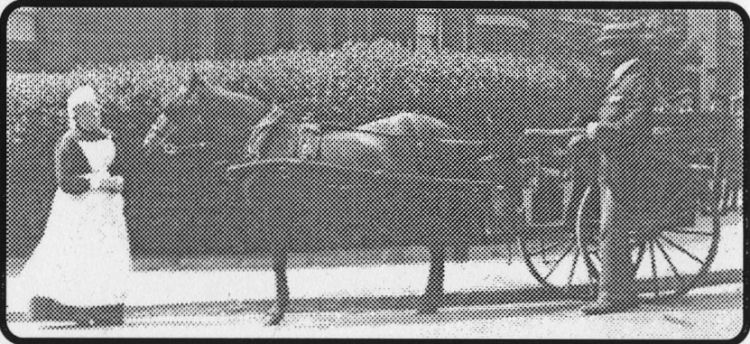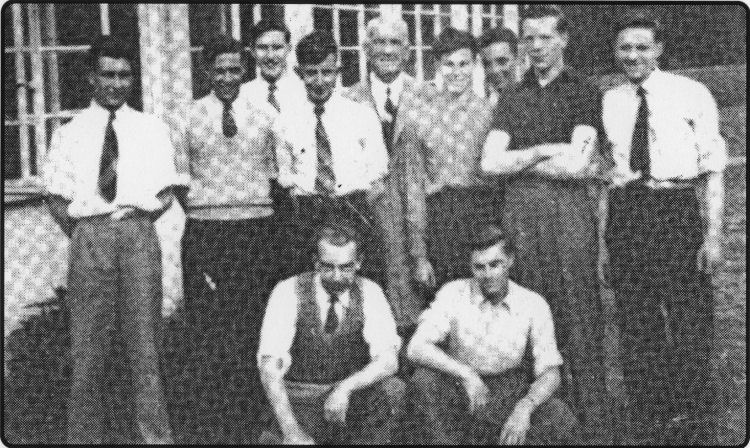
Published 2 October 2003


READER Barbara Long, of Charlotte Street, Folkestone, couldn’t believe
her luck when she saw a rather special photograph in Memories recently. This
was connected with the former St Andrew’s convalescent home overlooking the
harbour.
The reason? The photo (part of it shown above) was identical to a lost
family picture she had been hoping- to find for years.
Pictured is an ancestor who was in charge of a pony and trap and had worked
both for the St Andrew’s home and “Little Grange,” now site of a Technical
College building in Shorncliffe Road, but once a home for young gentlemen,
said Barbara.
The trap was used to give patients an outing and for other tasks in
connection with running St Andrew’s in the early part of the 20th Century.
The driver - a coloured man - doubled as a gardener.
“I recognised the picture straight away, as the family once had an identical
photograph in an album, but it was somehow ‘lost,’ she told me.
And Barbara and Barry Long were delighted when Memories reader Paul Bmden
agreed to supply them with a copy of the old postcard which is in his
collection of pictures of St Andrew’s, where he lives.
Meanwhile the Herald was able to present the couple with a computer
print-out of the postcard I had scanned for the Memories page, as Barbara
drooled over the picture.
Mrs Long has been researching her “fam-
ily tree” for 17 years and the re-appearance of a copy of the missing photo
has given her quite a boost.
She identified the coloured trap driver as James John Fitzgerald, who was
born in Eastry, near Sandwich. He died locally and is buried in Hawkinge,
she told me.
His father was Caesar Fitzgerald, once a steward on sailing ships. He was
born in Sierra Leone, and served on sailing barques, such as the British
Isles and the Pasha, plying between Liverpool or London and the West Indies,
among other countries.
He later married Rebecca Mills, daughter of John and Charlotte Mills, and
lived at Little Walton, Eastry, where son James and other children were
born.
Both James and his wife, Annie Scrivens, were living and working in Eythorne
when they married in 1878, but later moved to Folkestone.
Bouncing bomb
Gerald Taylor called me to comment on Dennis Stone’s Dover Road School and
other local memories of the Second World War featured back in August, to say
he remembered the day Folkestone was hit by a VI (not a V2) which flattened
Bridge Street.
At the time he was at St Mary’s Road school and had good reason to retain
vivid memories of the event - he had to take cover under the desk when the
classroom ceiling came down! He also recalled an incident when a bomb
bounced. It went right over the recreation ground, he said,
FOLKESTONE based apprentices who studied in a motor vehicle class at
Canterbury Technical College around 1952. The photo was shown to me by
Folkestonian Gerald Taylor, now livinp in St Mary-in-the-Marsh, who used to
work for Rootes, starting work at their garage in Tontine Street when it was
Southern Autos, in 1947. Gerald does not appear in the photo because he took
it! The line-up he recalls is, back row, left to right: Mark Hogben, Alan
Vine, Mick Sparks, Dil Russell, teacher Mr Patterson, Roy Shearer, Peter
Burton, Cliff Whittingstall; front: ‘Qzzie’ Osbourne, -?-.
Gerald Taylor also brought into the office the apprentices photo above which
he took for his fellow classmates at Canterbury Technical College, 50 years
ago. The quality has suffered because he didn’t keep one for himself and
this is a copy made for him by former classmate Cliff Whittingstall, now
living in Albany, Western Australia.
After employment in the garage trade Gerald switched to working at Dungeness
Power Station, from 1969 to 1993.
Bab's delight
and smashed into Archer Road.
Dover Road School old boy Ron Dutt, of St Michael’s Street, contacted me by
e-mail to tell me he was in a Memories page photo of boys of the school
visiting-Ashford Railway Works in 1947. “I was standing second from right in
the front row, wearing a black jacket,” he writes.
Ron went on to point out that the club I referred to in Memories recently
was the A.V.S. Club, not the A.B.S. club -which is what I typed in error!
 |
Felix recalls a black day in Folkestone’s history
*1 QAQ HERALD writer Felix was prompted to Xi/UOIook back to a black day
in the history Df the town after noting with pleasure that the Mayor and
his young daughter had attended the Salvation Army's harvest festival.
He recalled "shocking and riotous scenes" associated with an earlier
mayor when followers of General Booth were threatened and attacked bv a
mob. fhey taunted and threatened the fledgling Salvation Army group day
after day, week after week, he said. I well remember the opening
Saturday night, on November 5. Capt Frank Smith, blowing a solitary
cornet, and two or three followers, faced a howling mob, and ventured to
parade the streets. Squibs, crackers, mud, and bricks followed the
course of the small procession, police were tossed about as corks
on a stormy sea." Eventually a High Court action established the right
of the Salvation Army to go about its work. £ven so some townsmen were
Fined, or sent to prison for further threatening behaviour. Those
difficult days are described in "The Old Corps," a small paperback by
one-time officer Edward H Joy, first published in 1944 and reprinted in
1975.
|
Council takes up case of toll-hit local fishermen
«f COUNCILLOR John Barfoot spoke up
-L«/^Ofor Folkestone fishermen who were being unfairly penalised. They
had to pay a commission to the auctioneers who sold their fish at the
fishmarket and were also saddled with the payment of landing charges to
the Southern Railway who owned the port. But other traders, not
ratepayers, from Ashford, Canterbury and Dover, also brought fish into
the market by road and rail to be sola, and escaped landing charges,
effectively getting more for their fish. Some of it, he believed, came
from Grimsby! But Folkestone Corporation Act clearly stated local
fishermen had a free market and no tolls should be levied. He believed
this fish from 'outside' amounted to between one and four tons a day,
almost every week, including Sundays. The Town Clerk said he didn't see
how the Railway could control the fishmarket, it was on Folkestone
Corporation land! It was decided to set up a committee, including the
mayor and deputy mayor, to look into the question - and that of
"cheapjack" traders infiltrating the Stade area. Brave Folkestone
soldier 2nd Lieutenant Leo Adams-Acton, 23, a PoW in Korea, who was
executed by his captors, was awarded the Military Cross for bravery
after missions behind enemy lines.
|
Protest as low-flying jets recall wartime attacks
m Q CO THE COUNCIL was all set to write to .L«/0«3the Air Ministry
complaining of low flying by jet aircraft which were said to "skim the
rooftops." Councillor T.L.E. Franks said how frightening the noise could
be to those who had experienced attacks on Folkestone by enemy planes in
the Second World War. Another councillor saw planes flying below the
level of the Leas, while the mayor spoke of that week's Cinque Ports
church service at Dover when noise of low-flying planes drowned the
words of the mayor's chaplain giving an address. It was suggested the
aircraft were USAF jets based at Manston. The paper featured a photo of
an 'old crock,' a 50-year-old American Cadillac in which 79-year-old
Frederick Stanley Bennett, owner of the open car, re-enacted the journey
he made 50 years earlier, in a London to Folkestone leg of a 1,000
reliability trial. He had completed 500 miles without a breakdown. Ann
Winstanley, 15, of Bradstone Avenue, Folkestone, was crowned "Queen of
the Hop Gardens" at a dance at Chilham village hall and her sister
Valerie, 17, came second. A London girl was third.
|
Ghost hunters investigate tale of the 'Cavalier’ killer
»f Q^Q GHOST hunters were active in f O Shepway and spooks in a country
pub at Bridge, UFOs at Acrise and similar sightings were their special
interest. The group, 19 strong, were all members of a recently formed
organisation named Probe 4. Monthly meetings were held and founder
member Jimmy Rawlins, 36, of Radnor Park Road, believed the group was
really taking off. One of the spectres investigated was possibly a ghost
connected with a Cavalier supposed to have murdered his maid and
illegitimate child to cover up his liaison. Angry councillors attacked
plans to divide £22,000 council lottery money between each town and
parish council in the district on the basis of population figures. The
Grand, converted back to apartments, 25 years ago, was one of the first
buildings in which reinforced concrete was extensively used - the almost
entire absence of wood being considered a great deterrant to the
"ordinary hotel cockroach," it was stated! A councillor claimed half the
people in Lydd were prisoners in their own homes because they couldn't
afford to go out, and he backed a move to get an East Kent Road Car
Company "Freedom Ticket" scheme for Lydd. |
|



